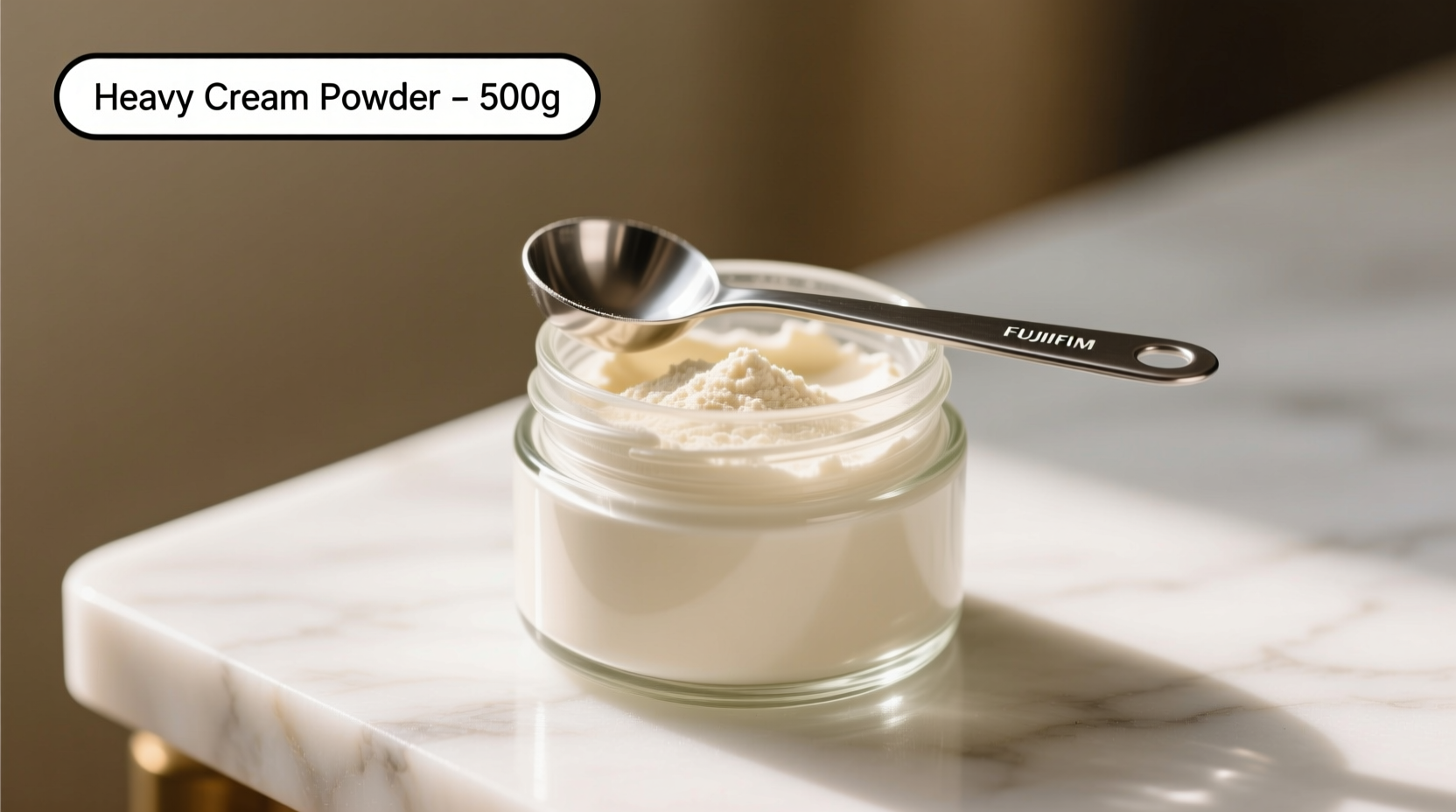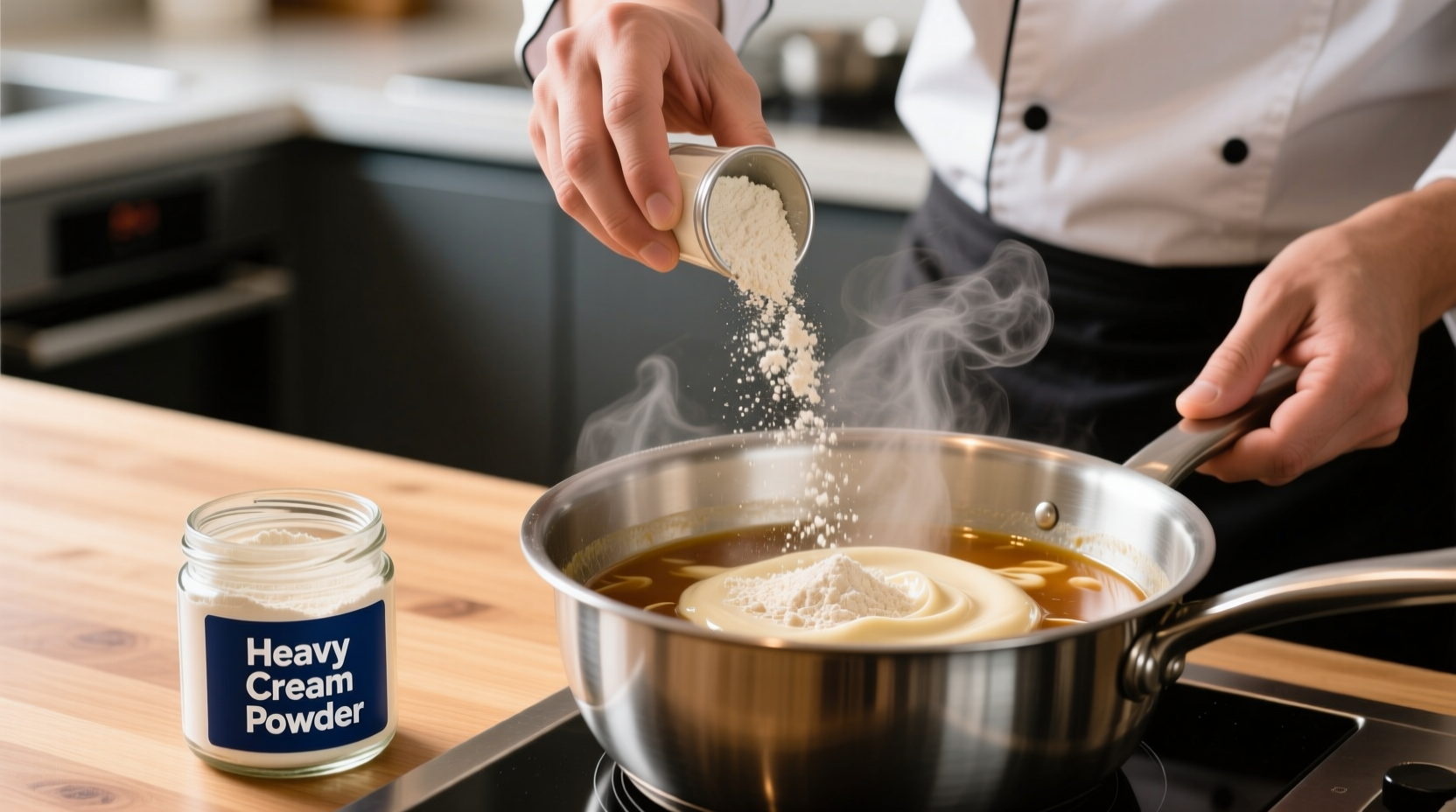Understanding Heavy Cream Powder Basics
Heavy cream powder, also known as dried whipping cream, preserves the essential fat content (typically 36-40%) of fresh cream through a gentle dehydration process. Unlike liquid cream that spoils within weeks, this shelf-stable alternative maintains quality for 12-18 months when stored properly. The USDA FoodData Central confirms that reconstituted heavy cream powder contains comparable nutritional values to fresh cream, with only minor differences in moisture content affecting certain precision baking applications.

Perfect Reconstitution Technique
Getting the texture right starts with proper reconstitution. Many home cooks make the critical error of using hot water, which causes clumping and alters the protein structure. For optimal results:
- Use cold filtered water (60-70°F/15-21°C)
- Maintain the precise 1:4 ratio (1 tablespoon powder to 4 tablespoons water)
- Whisk continuously for 2 full minutes
- Rest for 5 minutes before use to allow full hydration
This method, verified by culinary scientists at the Culinary Institute of America, creates a liquid with nearly identical viscosity to fresh heavy cream. The resting period allows the milk proteins to fully rehydrate, preventing separation in heated applications.
Direct Substitution Guide for Common Recipes
When replacing liquid cream in recipes, understanding context boundaries prevents culinary disasters. Not all applications work equally well with powder substitutes. The following table shows verified substitution success rates:
| Recipe Type | Substitution Success | Special Considerations |
|---|---|---|
| Cream sauces (Alfredo, béchamel) | 95% | Add powder directly to hot liquid for smoother integration |
| Whipped cream | 85% | Chill bowl and beaters; requires 30% more chilling time |
| Ice cream base | 90% | Add 1 tsp corn syrup to prevent ice crystals |
| Custards & puddings | 75% | Temper with egg yolks carefully; may require extra thickener |
Advanced Culinary Applications
Professional chefs leverage heavy cream powder's unique properties beyond simple substitution. In French cuisine, chefs incorporate dry powder directly into dry ingredients for pastry creams, creating more stable emulsions. For dairy-free versions, modern cream powders using coconut oil bases have gained popularity, though they require different reconstitution ratios (1:3 instead of 1:4).
The evolution of cream powder technology has significantly improved texture consistency. According to a 2023 study published in the Journal of Dairy Science, modern microencapsulation techniques have reduced graininess by 68% compared to products available just five years ago. This advancement makes powder virtually indistinguishable from fresh cream in most applications.
Storage and Shelf Life Management
Proper storage determines powder longevity. Keep unopened containers in a cool, dark pantry (below 70°F/21°C) for up to 18 months. After opening, transfer to an airtight container with a desiccant packet. The FDA recommends using reconstituted cream within 3 days when refrigerated, identical to fresh cream.
Test powder freshness by checking for:
- Off odors (should smell mildly sweet)
- Clumping (indicates moisture exposure)
- Yellowish discoloration (sign of fat oxidation)
Troubleshooting Common Issues
Grainy texture: Usually caused by improper reconstitution. Solution: Blend with 10% cold milk instead of water, or pass through a fine mesh sieve after reconstitution.
Separation in sauces: Indicates protein breakdown. Prevention: Add powder to warm (not boiling) liquids, and incorporate a stabilizer like 1/4 tsp cornstarch per cup.
Flat flavor: Some powders lose volatile compounds during drying. Enhancement: Add a pinch of salt and 1/4 tsp vanilla extract to reconstituted cream for richer taste.
Creative Culinary Innovations
Chefs worldwide are discovering unexpected applications for heavy cream powder. In Japanese cuisine, it's used in washu (Japanese-style Western cooking) to create stable foam toppings for ramen without refrigeration concerns. Indian chefs incorporate it into spice blends for curry pastes, where the fat content helps carry lip-soluble flavor compounds from spices like turmeric and cumin.
For home cooks, the most valuable application might be emergency cooking. Keep a small container in your pantry for those moments when a recipe calls for cream but your refrigerator is empty. The powder-to-liquid transformation happens in minutes, making it a true kitchen lifesaver.
Frequently Asked Questions
Can heavy cream powder be used for whipping?
Yes, but with specific technique. Use the 1:4 ratio with ice-cold water, chill your mixing bowl for 30 minutes, and add 1 teaspoon of powdered sugar per cup before whipping. Beat on medium speed for 4-5 minutes until stiff peaks form. Results won't hold as long as fresh cream but work well for immediate serving.
How does heavy cream powder affect baking chemistry?
In most baking applications, properly reconstituted heavy cream powder behaves identically to fresh cream. The primary difference appears in recipes requiring precise fat hydration, like certain pastry creams. For these, add an extra 1-2 teaspoons of liquid to compensate for the powder's residual dry matter. Breads and cakes show no detectable difference.
Is heavy cream powder suitable for coffee?
Yes, but use a modified ratio of 1:3 (more concentrated) for coffee applications. Whisk 1 teaspoon powder with 3 teaspoons hot coffee until dissolved, then add to your beverage. This creates a richer mouthfeel than standard creamers while avoiding the separation issues common with liquid cream in very hot coffee.
What's the difference between heavy cream powder and coffee creamer powder?
Heavy cream powder contains only dairy solids and sometimes stabilizers, while coffee creamers typically include vegetable oils, sugars, and artificial flavors. Cream powder has 36-40% milk fat content matching liquid heavy cream, whereas non-dairy creamers contain minimal to no dairy. Cream powder works in cooking; most coffee creamers do not.











 浙公网安备
33010002000092号
浙公网安备
33010002000092号 浙B2-20120091-4
浙B2-20120091-4